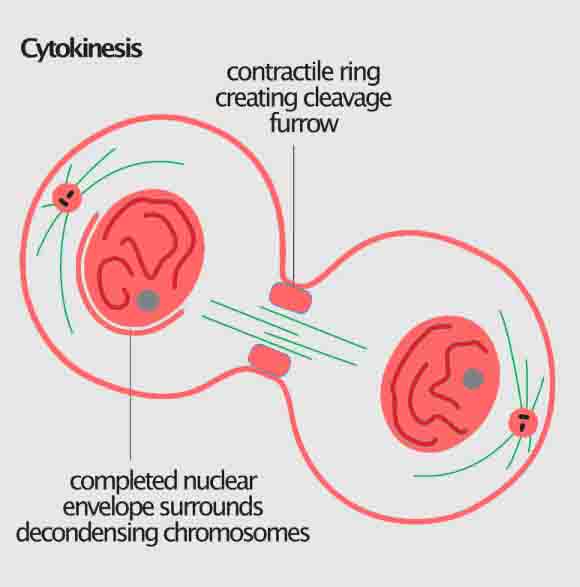Definition and Process In animal and Plant Cells Biology Diagrams Cytokinesis is the physical division of the cell cytoplasm, the cell membrane, and cell organelles in eukaryotic cells to produce two distinct cells at the end of the cell cycle in both mitosis and meiosis. In most cells, cytokinesis is initiated during the anaphase stage and ends in telophase, a phase where the chromosomes are completely The cell cycle of eukaryotes is a cyclical series of biological events that certain asexual cells go through. The cell cycle is comprised of these fundamental events: (1) resting phase (Gap 0), (2) interphase (Gap 1, S phase, Gap 2), and (3) cell division (i.e. mitotic phase and cytokinesis).In essence, the cell may enter a quiescent stage called the resting phase or it may go through the rest Cytokinesis illustration Cilliate undergoing cytokinesis, with the cleavage furrow being clearly visible.. Cytokinesis is the division of cells after either mitosis or meiosis I and II.. During cytokinesis, the cytoplasm (the liquid center of the cell that holds the organelles into place) splits into two equal halves, and the cell becomes two daughter cells. . This occurs right after the

Cytokinesis illustration Ciliate undergoing cytokinesis, with the cleavage furrow being clearly visible.. Cytokinesis (/ ˌ s aɪ t oʊ k ɪ ˈ n iː s ɪ s /) is the part of the cell division process and part of mitosis during which the cytoplasm of a single eukaryotic cell divides into two daughter cells. Cytoplasmic division begins during or after the late stages of nuclear division in Definition of Cytokinesis: Cytokinesis is the division of the cytoplasm of the parent cell into two daughter cells at the end of mitosis or meiosis. Explanation. Initiation . The contractile ring initiates and starts to build a cleavage furrow. This happens in the anaphase.

Simple English Wikipedia, the free encyclopedia Biology Diagrams
Cytokinesis Definition. Cytokinesis is the final process in eukaryotic cell division, which divides the cytoplasm, organelles, and cellular membrane. Cytokinesis typically occurs at the end of mitosis, after telophase, but the two are independent processes. The cell cycle culminates in the division of the cytoplasm by cytokinesis. In a typical cell, cytokinesis accompanies every mitosis, although some cells, such as Drosophila embryos (discussed later) and vertebrate osteoclasts (discussed in Chapter 22), undergo mitosis without cytokinesis and become multinucleate. Cytokinesis begins in anaphase and ends in telophase, reaching completion as the

Cytokinesis is the final stage in the cell cycle, when a new generation of daughter cells is formed through the splitting of the cytoplasm and the separation of the two identical cells. This signals the start of a new cellular generation. For any organism to grow and survive, it requires new cells to be formed. A human embryo—a single cell

